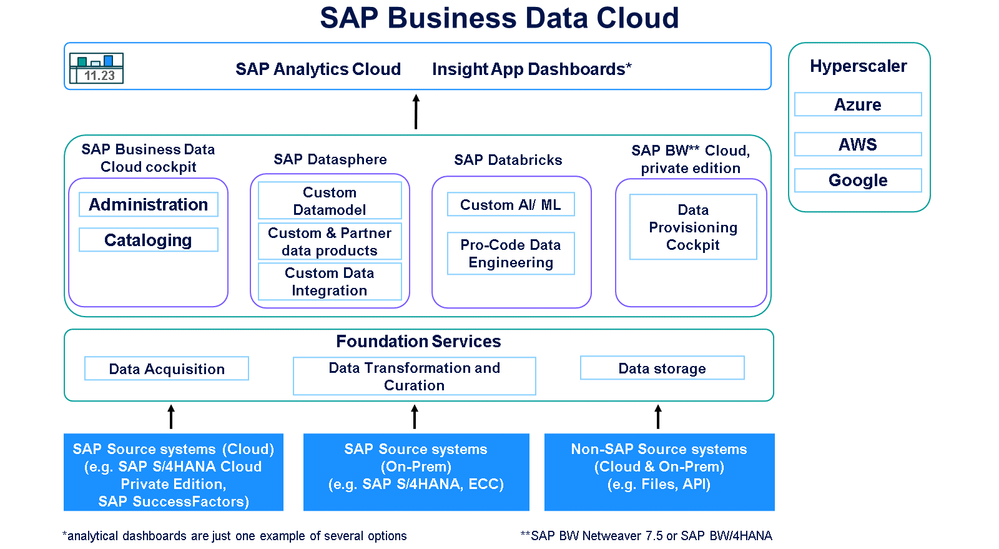
In February 2025, SAP introduced SAP Business Data Cloud (BDC) – a fully managed SaaS solution that unifies SAP and non-SAP data, seamlessly connects to third-party data sources, and delivers business-ready insights through prebuilt content, AI, and advanced analytics capabilities. It’s designed to help business leaders make faster, more confident decisions using data that’s already shaped by business context.
What sets BDC apart is not just the integration of familiar SAP components – SAP HANA Cloud, SAP Datasphere, and SAP Analytics Cloud (SAC) – but also its enhanced architecture and extensibility through Databricks, which brings AI/ML tooling and scalable data engineering into the SAP ecosystem.
This article provides a high-level overview of SAP Business Data Cloud from a finance and accounting lens, including potential benefits, key use cases, and the evolving architecture behind it.
Note: As of Q1 2025, BDC is in a controlled general availability release, with broader rollout and licensing details expected later this year.
What Is SAP Business Data Cloud (SAP BDC)?
SAP Business Data Cloud (BDC) is SAP’s next-generation, fully managed SaaS platform that combines the power of SAP Datasphere, SAP HANA Cloud, and SAP Analytics Cloud into a single SaaS solution. It’s designed to help organizations integrate, model, analyze, and act on data – all within a unified environment that connects business and technical users.
With BDC, SAP moves away from siloed data warehouses or disconnected analytics tools, adopting a business-context-first approach. Data is transformed into Data Products, organized in ways that reflect how people work – not just how systems store information.
For finance and accounting teams, this represents a pivotal shift – especially for those relying on SAC for planning, analysis, and forecasting. With SAC now embedded in BDC, it becomes the primary interface for decision-making across the unified platform.
At its core, BDC aims to:
- Replace fragmented reporting solutions with prebuilt, business-ready insights
- Streamline access to SAP and non-SAP data sources
- Enable AI/ML-powered decision-making
- Support modern planning and analytics from a single, integrated platform
SAP Business Data Cloud Architecture Overview
SAP BDC is built on several interconnected layers that ingest, refine, enrich, and deliver business-ready data. Here’s how it all fits together:
- Source Systems Integration: SAP BDC connects to both SAP systems (e.g., S/4HANA, SuccessFactors) and non-SAP sources. Data is bundled into structured entities (like tables or views) and replicated to the cloud.
- Foundation Services and Data Products: Data is harmonized and transformed into Data Products using SAP Foundation Services, hosted in SAP HANA Cloud or Data Lake files. SAP manages integration and cleansing.
- SAP Datasphere Modeling: SAP Datasphere is the modeling layer on top of Data Products, supporting custom models, role-based access, and integration with external tools and applications.
- SAP Databricks for AI/ML: BDC includes a Databricks-based object store and ML/AI toolset, enabling advanced analytics, predictive modeling, and data enrichment. Data can move between BDC and Databricks via Delta Sharing, enabling a modern data science workflow within the SAP environment.
- SAP BW and SAP BW/4HANA Compatibility: Existing BW assets can be integrated as Data Products. For customers still on BW 7.5 or BW/4HANA, BDC offers a modernization path with extended support through 2030.
- SAP Analytics Cloud Front-End: SAC remains the front-end for dashboards, forecasting, planning, and ad-hoc analysis. With BDC, SAC becomes more powerful – consuming Data Products, leveraging AI assistants like Joule, and enabling federated planning across the suite.
- Insight Apps & BDC Cockpit: Prebuilt Insight Apps offer planning and reporting tools, while the BDC Cockpit allows users to manage Data Products, deploy applications, and integrate AI tools.

The goal is to deliver real-time access, business context, and a single version of the truth – without building a traditional data warehouse.
Benefits for Finance and Accounting Teams
SAP Business Data Cloud is more than just a data integration tool. It represents a shift toward context-rich, prepackaged analytics that reduce complexity and accelerate insights for business users. Here are the key benefits – especially for finance teams:
1. Unified Data Foundation with Business Context
BDC connects structured and unstructured data across systems while preserving critical business semantics. This simplifies analysis and ensures stakeholders see data in a format that reflects how the business actually operates.
Why it matters: Finance and accounting teams spend less time reconciling data and more time driving strategic insights.
2. Embedded AI/ML Capabilities
By integrating Databricks, BDC extends SAP’s data platform with enterprise-scale machine learning and data science tools – without forcing you to move data out of the SAP ecosystem.
Why it matters: Teams can build smarter forecasts, detect anomalies earlier, and explore new use cases like intelligent cash flow modeling.
3. Lower TCO with Scalable Storage
With an object store powered by Databricks, customers no longer rely exclusively on in-memory HANA storage. This shift to hybrid storage options can help reduce overall costs.
Why it matters: Customers can balance performance and cost without compromising on data quality or insight.
4. Prebuilt Content to Accelerate Time-to-Value
Insight Apps and predefined Data Products provide a fast start for common use cases – from working capital analysis to headcount planning – with minimal configuration.
Why it matters: Business users get instant access to useful content, while IT teams spend less time building from scratch.
5. Seamless SAC Integration
SAC is no longer a standalone solution but part of the BDC platform. This means deeper integration with the data layer, stronger planning capabilities, and improved user experiences.
Why it matters: Finance teams already using SAC will see an expanded set of capabilities – without switching tools.
SAP Business Data Cloud in Action: A Finance Use Case Example
Let’s say your controller wants to analyze how inventory delays are impacting working capital:
- Data is pulled from SAP S/4HANA and supply chain systems into SAP BDC.
- It’s harmonized and transformed into a Data Product for working capital analysis.
- A prebuilt Insight App in SAP Analytics Cloud shows KPIs, trends, and variances.
- Finance extends the analysis by applying ML forecasting in SAP Databricks to predict future impacts.
- The team uses planning tools in SAP BDC to model potential outcomes and update projections.
Potential Challenges with SAP Business Data Cloud
- Licensing Complexity: It’s still unclear how existing SAP BW or SAC customers will transition without overlapping costs.
- Integration Flexibility: While SAP BDC is “open,” connectivity with non-SAP front ends may be limited.
- Learning Curve: Concepts like Data Products and Datasphere modeling may be unfamiliar to traditional finance users.
- Vendor Lock-In Risk: The bundled nature of SAP Business Data Cloud may limit flexibility for organizations with mixed tech stacks.
Why It Matters for Finance Transformation
Finance teams are under pressure to move faster, plan better, and provide real-time insights to the business. SAP BDC is designed to support that shift – enabling teams to spend less time managing data and more time driving strategy.
It brings together data integration, business modeling, forecasting, and analytics into one platform. That means fewer tools to manage, fewer handoffs between teams, and more confidence in the decisions you make.
For Current SAP Customers
If you’re currently using SAP Analytics Cloud or SAP BW, here’s what you need to know:
- SAC is now embedded in BDC. Your SAC dashboards and planning workflows will be more tightly connected to the underlying data layer.
- BW customers get a clear migration path. SAP BDC supports reuse of BW assets as Data Products, preserving past investments.
- Analytics, planning, and AI are converging. Instead of managing separate tools, SAP BDC brings everything into one connected experience.
Final Thoughts: A Promising Vision, Still Early Days
SAP Business Data Cloud represents an ambitious shift in how SAP envisions enterprise data access—especially for finance and accounting teams who’ve long struggled with fragmented data environments.
But like any new solution, the details of how it performs in real-world scenarios are still emerging. Finance leaders evaluating SAP BDC should approach it with cautious optimism–recognizing both its potential value and the questions still unanswered about performance, scalability, and integration effort.
One thing is certain: AI and automation are becoming critical to modern finance teams. From predictive forecasting to anomaly detection, AI-driven insights help organizations move beyond static reporting to proactive decision-making. By embedding AI/ML capabilities through Databricks and prebuilt Insight Apps, SAP Business Data Cloud aims to provide finance teams with more intelligent, real-time analytics, without requiring extensive data science expertise. For organizations looking to future-proof their finance function, BDC could represent a significant step forward.
Want to learn more? Contact us to explore how SAP Analytics Cloud with Business Data Cloud can streamline your finance operations.



